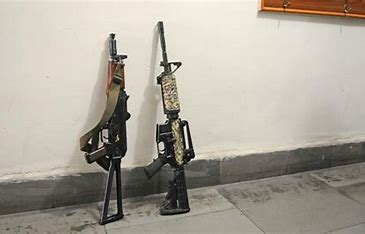According to sources in Kabul, the M4 was being brought to be used in India not from Kabul but from multiple other sources by terrorist groups.
NEW DELHI: The emergence of M4 carbine guns in the hands of terrorists coming from Pakistan into Jammu and Kashmir has put the spotlight on Kabul, with narratives and reports suggesting that these weapons were being exclusively procured and arranged from Afghanistan, where the Taliban are in power.
These narratives, not surprisingly, have been traced to channels that identify their interest with Western countries.
India, prioritizing its strategic interests and longstanding ties, is one of the few countries that has maintained a positive working relationship with the Taliban government in Kabul, a move that has been met with disapproval from certain entities.
In the recent terror attack at a workers’ camp in Ganderbal district of Jammu and Kashmir, in which seven people were killed, CCTV footage showed the terrorists armed with M4 guns.
However, according to sources based in Kabul, the M4 type of gun was being brought to be used in India not from Kabul but from multiple other sources by these terrorist groups.
Taliban sources said that when the American and other North Atlantic Treaty Organization (NATO) forces were operating in Afghanistan, they were being supplied essential items, including arms and ammunition, via Karachi in Pakistan and Khyber Pakhtunkhwa (KPK), which borders Afghanistan.
This KPK route has historically been used for transporting goods, military supplies, and humanitarian aid, connecting Karachi, Pakistan’s largest city and main seaport to Khyber Pakhtunkhwa, which borders Afghanistan and acts as a transit zone to Kabul.
When these military equipment convoys would cross the KPK, these trucks would be attacked by members of different armed groups and militias that are active in the region, who would then get their hands on M4 and other American-made rifles from the convoy.
An official from a non-Indian government agency, who was present on the ground when the US forces were still operating in Afghanistan, told The Sunday Guardian at the time of the US occupation of Afghanistan, military equipment for US and NATO soldiers was primarily transported from Karachi using local drivers who drove trucks across the Torkham border into Afghanistan.
The Torkham border crossing connects Nangarhar province of Afghanistan with Khyber Pakhtunkhwa province in Pakistan.
In many instances, these drivers and elements of the Pakistani military, primarily from the intelligence agency ISI, would operate under a scheme: they would locate an old vehicle, detonate it or set it ablaze, and record the incident. This footage would then be sent to American forces, falsely asserting that the Taliban had attacked a truck loaded with weapons, leading to the destruction of the supplies inside.
This strategy offered two key benefits: first, the Pakistani military would seize the weapons and equipment for themselves; second, the drivers would receive new trucks from the Americans as compensation for their alleged losses.
Apart from that the M4 rifles were given to Khost Protection Force (KPF), formally known as the 25th Division by the (Afghan) Ministry of Defence, an Afghan paramilitary group that was trained and given resources by the Central Intelligence Agency (CIA). After the Taliban came to power, it is likely that these M4 were then sold or smuggled to Pakistan based groups.
According to Kabul based sources, at the time, the Afghan army and the police were using only M16, with the M4 being exclusively used by KPF and similar special units.
Afghan-based sources said that these M4 guns are also produced in the Dara Adam Khel block of Kohat District in Khyber Pakhtunkhwa province of Pakistan. The M4 assault guns produced in this area, which for more than a hundred years
According to a member of the intelligence community, the Chinese-made M4, which goes by the name of CQ-A, developed by Nornico, a Chinese state-owned defence corporation, is also available in Pakistan and bordering areas and can be easily procured.
The CQ-A was developed in the early 2000s as a semi-automatic version of the M4A1, reflecting China’s practice of reverse engineering successful foreign firearms. It was released in 2006 and soon found its way into Pakistan.
An official source in Afghanistan termed the reports of M4 guns being procured from Afghanistan to be used in Kashmir as “totally incorrect,” while indicating that some of these guns were in the possession of a few members of the erstwhile Afghan National Army who were allegedly working closely with the Pakistan army.

